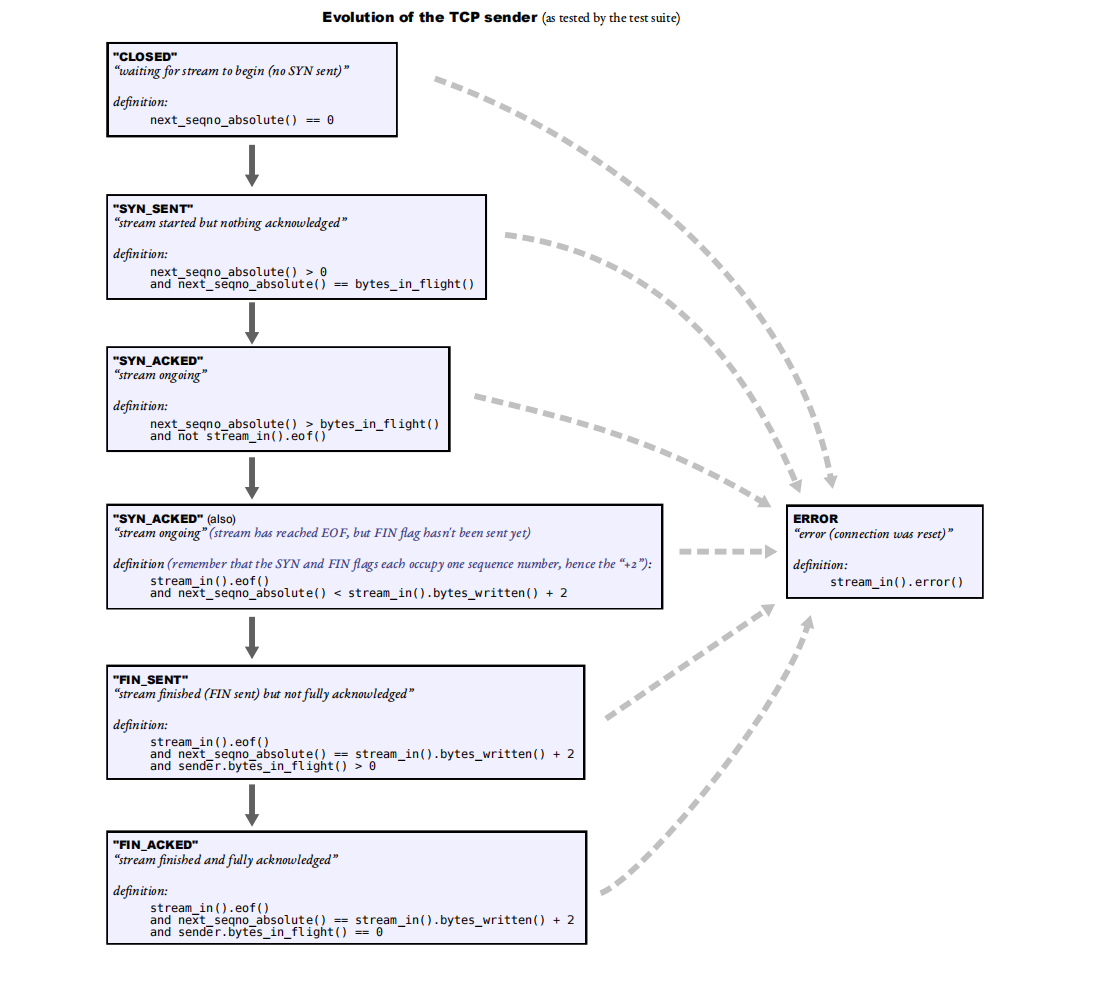| CS144 计算机网络实验 lab3 笔记 | 您所在的位置:网站首页 › cs144lab4 › CS144 计算机网络实验 lab3 笔记 |
CS144 计算机网络实验 lab3 笔记
|
CS144 计算机网络实验 lab3 笔记
介绍
本实验中,我们将会在之前实验的基础上,实现一个TCP sender ----将字节流转换成数据报并发送.
TCP协议是一个在不可靠的协议上提供可靠的,流量控制的协议。 我们在本实验中会实现一个TCP发送端,负责将发送端应用层传入的比特流转换成一系列由发出的TCP报文段,在另一端,由TCP接收端将TCP报文段转换成原始比特流(也有可能什么都不做,在从未受到syn,或者多次受到的时候),并将ack和窗口大小返回给TCP发送端 TCP接收端和发送端都负责处理一部分TCP报文段。TCP发送端写入到报文中的每部分都会被TCP接收端解析,包括:seq,SYN,FIN,内容 但是,TCP发送端只会一部分报文的内容,包括:ackno和SYN
TCP发送端有以下任务: 跟踪window size,也就是处理ackno和window sizes尽可能的填充 ( 自己的 ) windows,直到满了或者ByteStream空了为止对已经发送但没有收到ackno的报文段 ( 未被确认的报文段) 保持跟踪如果超出规定的时间,还没有收到对应的ack,就重新发送所有已经发送,但没有收到ackno的报文段 TCP发送端是如何知道报文段丢失呢?TCP发送端会发送一系列的报文段. 每个报文段都是来自ByteStream的子串加上位置索引seq,如果是第一个报文段,需要加上syn,最后一个需要加上fin 为了发送这些报文段,TCP发送端会对所有已发送的报文段保持跟踪,直到收到响应报文段的ack 具体实现: TCP发送端会定期的调用TCPSender::tick函数,来表明时间的流逝.TCP发送端负责监管已发出报文段,如果最早的已发出但没有收到ack的报文段,超出了规定时间,它将会被重新发送 实现记录时间,以及计算时间 每隔几毫秒,TCP发送端的TCPSender’s tick方法将被调用,它告自上次调用此方法以来已经过多少毫秒,不需要自己处理时间当TCP发送端初始化的时候,将会有一个retransmission timeout (RTO),这就是重传时间,重传时间是变化的,但是最初的超时时间都是一样的,需要调用_initial retransmission timeout实现一个重传定时器: 当重传时间到达时发出警告,超过重传时间关闭警告,只可以依赖tick方法,不可以根据现实时间每次一个数据报发送的时候,如果定时器没有开启,就要开启定时器当确认所有数据时,停止重传计时器如果调用tick后发现定时器过期: 重传最早的未收到ack的包如果windows size大小不为零: 你需要跟踪连续重传的数量,因为TCP连接需要据此判断连接是否出现问题,是否需要中断将重传定时器时长加倍,这叫做exponential backoff指数补偿,随着重传次数的增加,补偿的程度也会指数增长 在超过重传时间后重置重传定时器并开启 当成功收到数据 设置重传时间为初始值如果发送重传数据,就需要重启定时器将连续重传记录的数量置零 实现TCP发送端 Implementing the TCP sender 思路 void fill_window() TCP发送端被要求尽可能的读取ByteStream中的数据,并且形成数据报 ( 未发送 )确保每次发送的数据报的量正好等于TCP接收端窗口的大小使用TCPSegment::length in sequence space()得到seq,不要忘了SYN , FIN 也占用一个序列号,所以也占用窗口空间 void ack_received(const WrappingInt32 ackno, const uint16 t window size) 得到接收端TCP窗口的左沿和大小 , ackno理应大于所有已发送数据报的seq void tick( const size t ms since last tick ) 表示自从上一次发送后经过多少毫秒了.不需要我们来调用,参数的意义是距离上次调用经过了多少时间,这个不需要我们操心,我们需要实现每次调用tick()的时候函数做什么 void send empty segment() 生成空的数据报,只发一个ack
其他的都很好理解,看一下代码就能懂 总体来说,有点小复杂,总有一些地方不明了,最后借鉴了一位博主的实现成功完成 #include "tcp_sender.hh" #include "tcp_config.hh" #include #include // Dummy implementation of a TCP sender // For Lab 3, please replace with a real implementation that passes the // automated checks run by `make check_lab3`. template void DUMMY_CODE(Targs &&.../* unused */) {} using namespace std; //! \param[in] capacity the capacity of the outgoing byte stream //! \param[in] retx_timeout the initial amount of time to wait before retransmitting the oldest outstanding segment //! \param[in] fixed_isn the Initial Sequence Number to use, if set (otherwise uses a random ISN) TCPSender::TCPSender(const size_t capacity, const uint16_t retx_timeout, const std::optional fixed_isn) : _isn(fixed_isn.value_or(WrappingInt32{random_device()()})) , _initial_retransmission_timeout{retx_timeout} , _stream(capacity) , _rto{retx_timeout} {} uint64_t TCPSender::bytes_in_flight() const { return _bytes_in_flight; } void TCPSender::fill_window() { if (!_syn_sent) { _syn_sent = true; TCPSegment seg; seg.header().syn = true; send_segment(seg); return; } if (!_segments_outstanding.empty() && _segments_outstanding.front().header().syn) return; if (!_stream.buffer_size() && !_stream.eof()) return; if (_fin_sent) return; if (_receiver_window_size) { while (_receiver_free_space) { TCPSegment seg; size_t payload_size = min({_stream.buffer_size(), static_cast(_receiver_free_space), static_cast(TCPConfig::MAX_PAYLOAD_SIZE)}); seg.payload() = _stream.read(payload_size); if (_stream.eof() && static_cast(_receiver_free_space) > payload_size) { seg.header().fin = true; _fin_sent = true; } send_segment(seg); if (_stream.buffer_empty()) break; } } else if (_receiver_free_space == 0) { // The zero-window-detect-segment should only be sent once (retransmition excute by tick function). // Before it is sent, _receiver_free_space is zero. Then it will be -1. TCPSegment seg; if (_stream.eof()) { seg.header().fin = true; _fin_sent = true; send_segment(seg); } else if (!_stream.buffer_empty()) { seg.payload() = _stream.read(1); send_segment(seg); } } } void TCPSender::send_segment(TCPSegment &seg) { seg.header().seqno = wrap(_next_seqno, _isn); _next_seqno += seg.length_in_sequence_space(); _bytes_in_flight += seg.length_in_sequence_space(); if (_syn_sent) _receiver_free_space -= seg.length_in_sequence_space(); _segments_out.push(seg); _segments_outstanding.push(seg); if (!_timer_running) { _timer_running = true; _time_elapsed = 0; } } // See test code send_window.cc line 113 why the commented code is wrong. //! \param ackno The remote receiver's ackno (acknowledgment number) //! \param window_size The remote receiver's advertised window size void TCPSender::ack_received(const WrappingInt32 ackno, const uint16_t window_size) { uint64_t abs_ackno = unwrap(ackno, _isn, _next_seqno); if (!_ack_valid(abs_ackno)) { // cout _bytes_in_flight -= seg.length_in_sequence_space(); _segments_outstanding.pop(); // Do not do the following operations outside while loop. // Because if the ack is not corresponding to any segment in the segment_outstanding, // we should not restart the timer. _time_elapsed = 0; _rto = _initial_retransmission_timeout; _consecutive_retransmissions = 0; } else { break; } } if (!_segments_outstanding.empty()) { _receiver_free_space = static_cast( abs_ackno + static_cast(window_size) - unwrap(_segments_outstanding.front().header().seqno, _isn, _next_seqno) - _bytes_in_flight); } if (!_bytes_in_flight) _timer_running = false; // Note that test code will call it again. fill_window(); } // See test code send_window.cc line 113 why the commented code is wrong. bool TCPSender::_ack_valid(uint64_t abs_ackno) { return abs_ackno = unwrap(_segments_outstanding.front().header().seqno, _isn, _next_seqno) + // _segments_outstanding.front().length_in_sequence_space(); abs_ackno >= unwrap(_segments_outstanding.front().header().seqno, _isn, _next_seqno); } //! \param[in] ms_since_last_tick the number of milliseconds since the last call to this method void TCPSender::tick(const size_t ms_since_last_tick) { if (!_timer_running) return; _time_elapsed += ms_since_last_tick; if (_time_elapsed >= _rto) { _segments_out.push(_segments_outstanding.front()); if (_receiver_window_size || _segments_outstanding.front().header().syn) { ++_consecutive_retransmissions; _rto TCPSegment seg; seg.header().seqno = wrap(_next_seqno, _isn); _segments_out.push(seg); } |
【本文地址】
公司简介
联系我们


